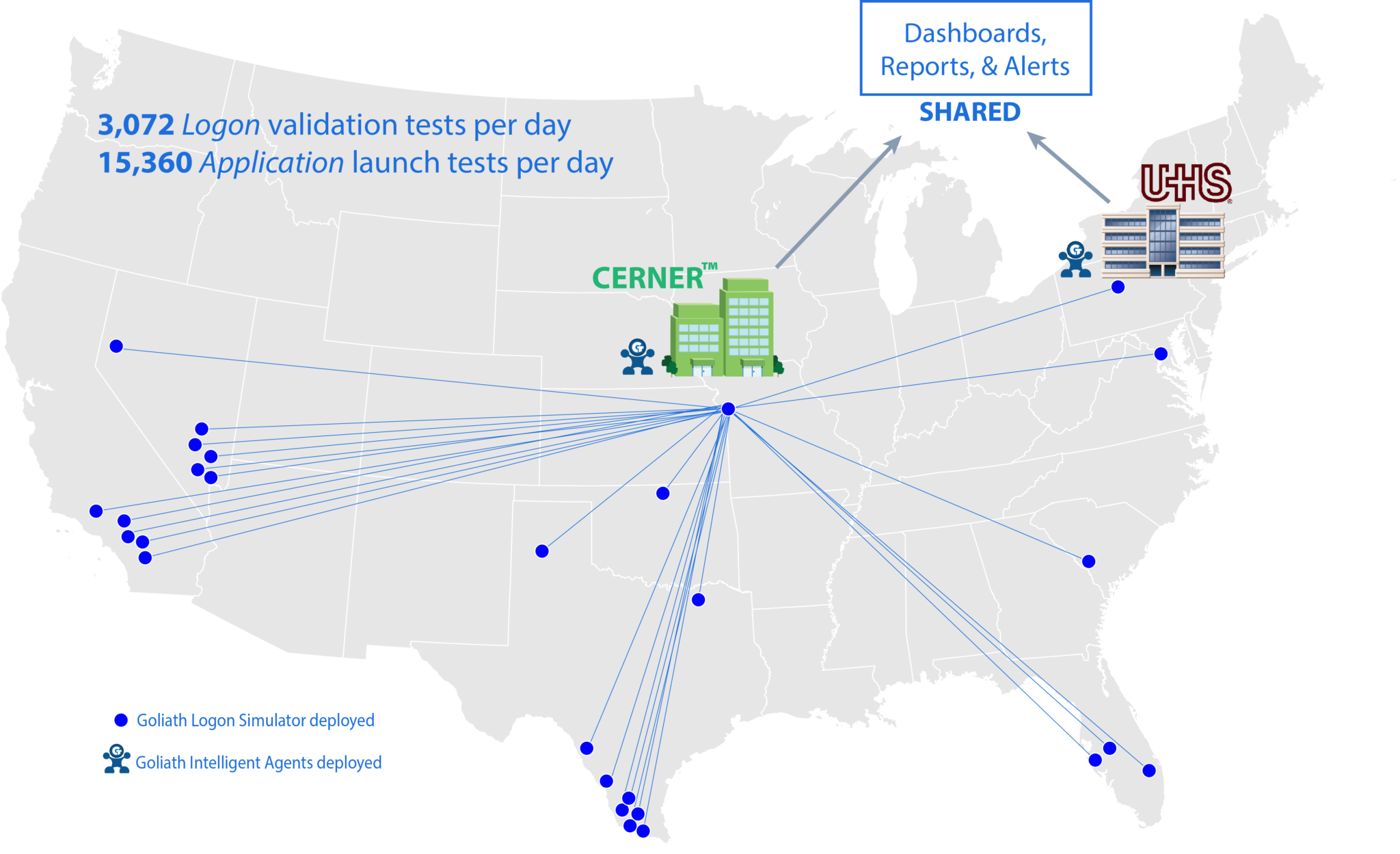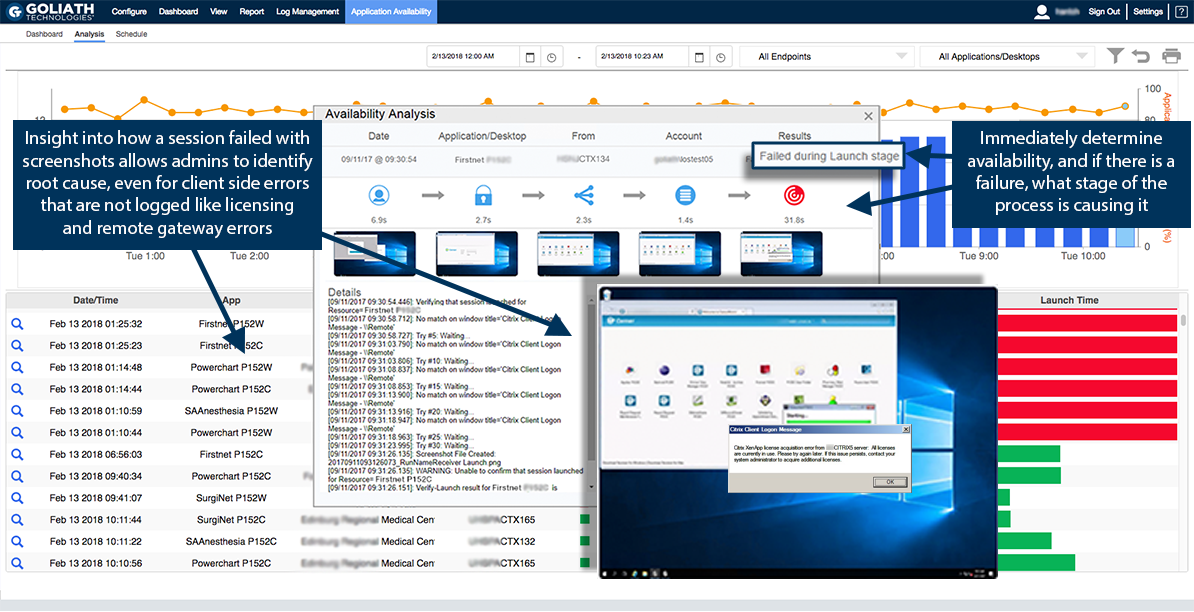Universal Health Services
Universal Health Services Uses Goliath to Prevent Cerner and VDI Logon Issues

“We selected Goliath Technologies because their end user experience monitoring and management supports Cerner and identifies systems degrading before physicians and patients are impacted. We do more than 15,000 Cerner application test launches per day. This early warning system coupled with enhanced performance data and analysis puts us in a better position to collaborate with Cerner to resolve issues.”
– Mike Nelson, Sr. VP of Strategic Services, Universal Health Services
Infrastructure
Cerner, Citrix
Challenge
UHS is one of the 10 largest for-profit health systems in the United States, and they rely heavily on Cerner to deliver EHR application services to healthcare professionals all across the country. They were faced with several challenges related to application failures and slowness, which impacted clinician and healthcare worker end user experience. More importantly, there was no solution in place for troubleshooting and/or providing advance warning when issues surfaced.
There Were Two Key Challenges Faced by UHS:
1. There simply wasn’t a technology available that could provide systems administrators at the hospital locations advance warning of clinician issues with the logon process, such as failures or slowness related to their Cerner-hosted application.
2. The distributed nature of the UHS user base and hospital locations presented challenges with identifying the root cause of logon initiation, logon duration and session-related issues. UHS required a solution that would enable them to quickly identify if an end user problem was occurring based on geography, site, application and/or the individual.
Solution
Test the Entire Citrix & Cerner Delivery Infrastructure
The combination of the above factors made it very difficult for UHS to get ahead of their application delivery challenges such that end user experience could be improved. Goliath provided them with a technology that enabled them to overcome the visibility limitations they were faced with and to resolve their logon performance and availability issues.
The Goliath team developed a technology called Goliath Application Availability Monitor. The technology is deployed at the remote hospital location and logs onto the Cerner application using Citrix.
It tests the entire Citrix and Cerner delivery infrastructure to ensure that both Citrix and Cerner will launch when clinicians and healthcare workers attempt to access their applications. The Application Availability Monitor may be deployed with or without the intelligent agent deployed on the Cerner XenApp servers. At UHS, the Goliath Application Availability Monitor was deployed at over 30 acute care facilities across the United States. At each facility, the Application Availability launch client is installed and configured on two physical workstations at each location. The Application Availability Monitor launches are configured to connect to the Cerner-hosted data center every 30 minutes, following the same network path as an everyday user.
15,000+ Cerner Application Logon Tests Per Day
Upon logging into the Cerner application delivery environment, the Application Availability Monitor launches five Cerner applications (PowerChart, Firstnet, SurgiNet, SAAnesthesia, and Pharmacy Med Manager). Launching these applications not only validates the availability of the programs, but it also exercises the entire logon initiation process. This ensures that all components are available and operating efficiently end-to-end. On a daily basis UHS IT performs over 15,000 Cerner application logon tests. These tests enable UHS to pinpoint and isolate availability issues before users are impacted, regardless of location.
The true power of the Application Availability Monitor technology is that it is not simply a series of automated scripts. It is software that initiates a connection to Cerner using the same logon sequence and process that a real end user follows to initiate a Citrix session. From a physical Windows Client or virtual machine, a Windows/Active Directory user account is configured to open a web browser, access the Cerner site, authenticate to the XenApp environment, launch the applications and then log out of the session(s). This entire workflow is conducted in the same manner that a user follows, down to the mouse clicks.
Accurately Representing the End User Experience in the Environment
The result is the most accurate representation of what an actual end user will experience when they access the environment. All of the metrics generated during the simulated session are reported back to the central end user experience support team at UHS in real-time. These metrics allow the UHS team to take immediate action whenever trouble arises. The following image depicts the deployment architecture.
The Application Availability Monitor is also a powerful tool for hospitals using Citrix and Cerner when identifying whether an issue is widespread or location-specific. In one instance, users at one of the UHS hospital locations were having difficulty launching and using the Cerner application.
Analyzing Real-time Data
Based on feedback received from the individuals experiencing the problem, all signs pointed to the Cerner application being unavailable. However, after analyzing the real-time data produced by the Application Availability Monitor at other sites, administrators quickly realized that sessions and applications were launching successfully and functioning reliably across the country.
The Application Availability Monitor data provided the needed evidence required to identify the problem as site-specific, and not related to the Cerner application or hosted facility. As a result, the support team was able to focus immediately on the location where the issue was being experienced and identified unreliable hospital Wi-Fi as the root cause. As depicted below, each simulation is scheduled to run on a regular, reoccurring basis. If issues arise, notifications are sent in real-time allowing support teams to address the conditions immediately.
Directly from the primary dashboard, administrators and support staff have the ability to drill down into simulation events. This enables them to obtain detailed information as to why a test may have failed or underperformed. This actionable intelligence is then either used to troubleshoot and resolve the issue or is provided to third parties such as Cerner to collaborate on a resolution.
Results
Goliath Application Availability Monitor gave UHS the tool they needed to identify and address logon and application availability issues in advance of end users being impacted. It also provided them with the capability to quickly diagnose and target root cause.


